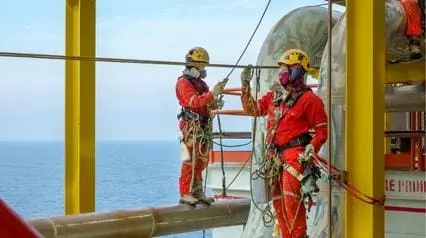What is a Height Access Equipment?
Height access equipment refers to any equipment that allows workers to reach an elevated area and accomplish a specific task in that space efficiently and, more importantly, safely.
Most people see this used in construction sites, where laborers are required to build several levels of a structure. But the demand for this is increasing in several other sectors, including manufacturing, facility management, and maintenance services. Basically, when working at height is called for, height access equipment is an indispensable requirement.
Types
There are different kinds of work at height access equipment. Aside from knowing what each type is specifically designed for, workers must understand the hazards each equipment poses so they can accomplish their job with little to no harm.
Ladders
Possibly the most straightforward of all types of access equipment for working at height, this is composed of repeated horizontal bars between two vertical poles and is used to climb up or down something.
There are different kinds of ladders depending on the following:
- Material used – wood, aluminum, fiberglass
- Maximum height it can reach – from 4 ft to 20 ft (~1.22 m to 6.07 m)
- Weight it can support – from 90 kg to 170 kg (~198.42 lbs to 347.77 lbs)
Possible Hazards:
- Defective equipment
- Uneven ground or base because of stepping too close to the top bars
- Overreaching
Trestles
This is used in lieu of ladders especially when two or more workers need to work at a height of up to 2 m (approximately 6 ft). Often used by decorators, trestles are composed of two or more standing bases and a staging board on top.
Possible Hazards:
- Lack of edge protection
- Instability (too thin platforms, mismatched bases, not enough bases)
- Overloading
Tower Scaffolds
Used mostly in engineering and maintenance, this independent scaffold can be erected and then dismantled for temporary work. It has four vertical poles fixed with several horizontal and transverse bars creating a frame and a platform where workers can stand. The maximum height of the tower should be 12 m (39 ft).
Possible Hazards:
- Faulty erection or dismantling
- Faulty or missing parts
- Lack of guard rails
- Overloading
- Bad weather conditions (e.g., too windy, rainy)
- Wrong ingress and egress on the scaffold
Fixed Scaffolds
Like the tower type, this also has vertical, horizontal, and transverse poles connected to each other to create a frame. The difference is that this is tied to a bigger structure like a building and used for large construction projects.
Possible Hazards:
- Poor design
- Faulty erection or dismantling
- Faulty and/or missing parts
- Lack of guard rails
- Poor maintenance and lack of inspection
- Overloading
- Bad weather conditions
- Wrong ingress and egress on the scaffold
Mobile Elevated Working Platforms (MEWPs)
What makes access equipment for working at height extra special is the inclusion of a motorized vehicle, which allows it to be driven on different kinds of terrain. There are two main types of MEWPs:
- Vertical MEWPs (a.k.a. scissor lifts) – The platform can only go in a vertical direction.
- Boom MEWPs (a.k.a. cherry pickers) – The platform can be extended horizontally or diagonally, used in areas where vertical lifting is not possible.
Possible Hazards:
- Unstable ground
- Catapult-type falls – where workers can be thrown from the platform during the lifting or extension
- Overloading
- Bad weather conditions
How to Choose the Right Equipment
Considering that there are numerous kinds of working at height access equipment, it is crucial to choose the most appropriate one for a specific task to ensure not just safety but also efficiency. A ladder, for example, may be a better option for changing a lightbulb at your workplace, but a boom lift is the better equipment for changing a lightbulb in a tree-lined street.
Below are some factors that must be considered before work starts:
- Height of the work site
- Number of people who will be working
- Type of work to be done (short-term vs. long-term work)
- Kind of tools that need to be brought up to the work site
- Ground condition
- Obstruction in the surrounding area of the work site
Risks Involved and Regulations Set
According to the Occupational Safety and Health Administration (OSHA), falls are one of the most common causes of work-related injuries. With over 350 fatal falls in 2020, OSHA reports that this is now the leading cause of death in the construction industry.
Because of these troubling statistics, the first rule of thumb set by health and safety regulators all over the world, like the OSHA and the Health and Safety Executive (HSE), is to avoid working at height altogether. If that is completely impossible, fall protection measures must be put in place.
Listed below are OSHA’s requirements in terms of fall protection:
- General industry – 4 ft
- Shipyards – 5 ft
- Construction – 6 ft
- Longshoring operations – 8 ft
Employers are also mandated to ensure safe working conditions and provide protective equipment like guard rails, toe boards, safety nets, and safety harnesses, among others. Training employees regarding job hazards is also a must.
Safety Guidelines for Using Height Access Equipment
The good news is that falls are completely preventable. Whether one is using a simple stepladder or getting strapped to scaffolding, there are numerous ways to ensure safety and prevent accidents from happening.
- Plan ahead – Know how the job will be done so that the safety precautions can be adequately put in place.
- Always use the right equipment for the job.
- Conduct a thorough inspection of the work at height access equipment.
- Never multitask (e.g., do not carry tools with your hand while climbing up a ladder).
- Always be on the lookout for unstable or fragile surfaces.
- Take the weather into consideration before starting work.
- Keep the surroundings clean and dry.
- Having adequate training on equipment use is a must!
FAQs about Height Access Equipment
Height safety personal protective equipment (PPE) includes the following:
- harnesses;
- ropes;
- shock absorbers;
- pole straps; and
- fall lanyards.
Yes. There are various training programs that should be taken for working at height, from equipment appreciation and inspection to installation and dismantling of the scaffolding. Check out OSHA regulations regarding training requirements for more information.
Inspection of all height access equipment and accessories should be done before and after use. On the other hand, maintenance of PPEs and fall arrest devices should be performed every six months. Meanwhile, maintenance of steel ropes or rails must be conducted every year.
Fall prevention is a passive way of preventing falls, e.g. use of guard rails on a second-story walkway. Meanwhile, fall restraints prevent workers from reaching and then tumbling over an unprotected platform (e.g., use of a body harness and lanyard fixed to an anchor). Lastly, fall arrest stops a fall that is already happening (e.g., lanyards that can carry 5,000 lbs or shock absorbers that can minimize injuries).




